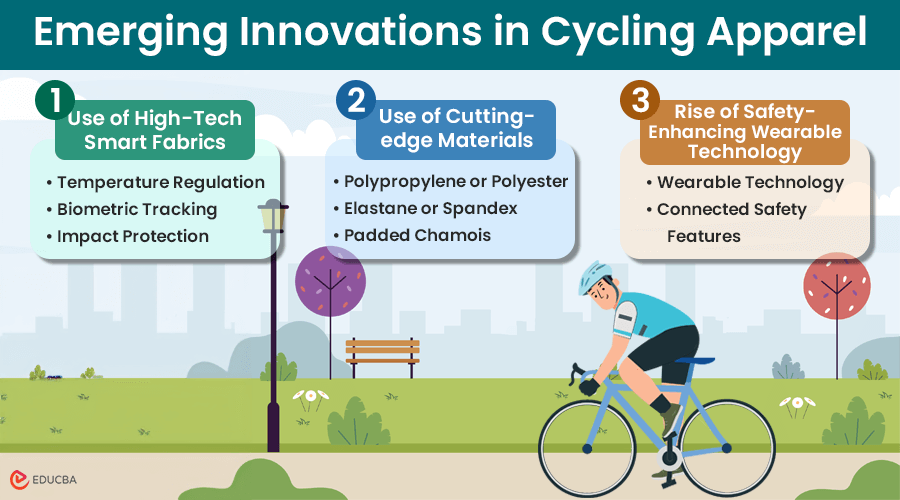How are Innovations in Cycling Apparel Benefiting Riders?
Have you noticed how advanced cycling gear has become? Lycra is now old news. These days, it’s all about fabrics that provide compression, wick moisture, block UV rays, and even have antibacterial properties. For avid cyclists, the right clothing can make all the difference in their active lifestyle and adventures on two wheels. That’s why cycling apparel brands are going all out to create high-performance fabrics. Innovations in cycling apparel are not just about style; they are about enhancing your riding experience with their advanced features.
So, let’s see how high-tech, high-functioning, and high-performance cycling clothing manufacturers can pave the way for the future.
Emerging Innovations in Cycling Apparel
#1. Use of High-Tech Smart Fabrics
Smart fabrics that can monitor your body and the environment are at the forefront when it comes to innovations in cycling apparel. Here’s how these fabrics take cycling clothing to the next level:
1. Temperature Regulation
New fabrics help regulate your body temperature by using microfibers and ventilation panels to move heat and moisture away from your body. Some fabrics even contain natural elements like minerals or bamboo fibers that adjust temperature naturally. This technology ensures you stay comfortable, and there is no more overheating on climbs or freezing on descents.
2. Biometric Tracking
Modern cycling apparel include sensors that track real-time metrics such as heart rate, breathing rate, and core temperature. This data is sent to your cycling computer or smartwatch, allowing you to monitor how your body responds during your ride. Some fabrics even have LEDs woven in to give visual alerts if your vitals go out of a predetermined range.
3. Impact Protection
Some companies are incorporating materials like Kevlar, airbag systems, and shock-absorbing gels into jackets, shorts, and gloves. These materials instantly inflate or harden upon impact to protect your joints and muscles. They then reset for the next hit, giving you a durable and lightweight alternative to bulky plastic guards.
#2. Use of Cutting-edge Materials
Modern cycling apparel use these cutting-edge materials to improve performance and safety:
1. Polypropylene or Polyester
Fabrics like polypropylene or polyester pull moisture away from your body, keeping you dry and preventing overheating. Mesh panels increase ventilation, ensuring airflow in critical areas like underarms and back.
In colder weather conditions, cyclists can wear cycling apparel made from polypropylene or polyester, which includes insulated fabrics with synthetic fill. Synthetic insulation retains body heat effectively while remaining lightweight and compressible.
2. Elastane or Spandex
Elastane or spandex, known for its ability to provide compression, works by gently squeezing muscles, which enhances blood circulation and reduces muscle vibration during cycling. This compression helps decrease muscle fatigue and can improve recovery times after rides.
Professional cyclists commonly use full-compression gear to maximize performance and endurance. Even recreational cyclists benefit from wearing compression shorts or socks, as they promote better circulation and support muscles.
3. Padded Chamois
Most cycling shorts now use multi-density foam pads, or chamois, designed to make long rides more comfortable. The foam pads in these shorts vary in density to help cushion sensitive areas and reduce soreness.
This seamless innovation in cycling apparel helps prevent friction, and their breathable, quick-drying fabrics keep you feeling cool and dry by pulling away sweat. Some women’s shorts even have extra padding in specific spots for added comfort and support.
4. Reflective Strips
If you ride at night, reflective details on cycling jackets, vests, and shorts help make you more visible to motorists for safety. These gears come with reflective strips, logos, or piping in strategic areas like the back, shoulders, and legs.
#3. Rise of Safety-Enhancing Wearable Technology
Several innovations in cycling apparel are revolutionizing what cyclists wear and how they interact with their gear. Here are some of them:
1. Wearable Technology
Fitness trackers and smartwatches have become popular for cyclists to track stats like speed, distance, and calories burned. Soon, these wearables may be integrated directly into cycling jerseys and bib shorts.
Tiny sensors woven into the fabric could monitor heart rate, respiration, and other biometrics as you ride. The data would sync to your mobile devices, giving you an in-depth analysis of your performance and health.
Some companies are even exploring haptic feedback clothing, where vibrating panels in jerseys might:
- Provide turn-by-turn navigation prompts.
- Alert you to hazards like cars in your blind spot.
- Send a buzz of encouragement when you are climbing a big hill.
2. Connected Safety Features
In terms of safety, future cycling wearables could feature smart fabrics with built-in LED lights that activate at night for visibility. They could also have embedded RFID chips linking to bike computers or fitness trackers. If there is an accident, the technology will automatically send an alert to emergency responders with your GPS location.
Additionally, some companies are developing “airbag” cycling vests that inflate upon impact to protect your torso. These could eventually connect to your bike, using sensors to anticipate a collision and instantly deploy the airbags before you even hit the ground.
Final Thoughts
Due to the many innovations in cycling apparel, the future is bright. There are advancements in high-tech fabrics, integrated wearables, and safety features. Thanks to new technologies and smart fabrics, clothing that enhances your experience and keeps you safer is becoming possible.
Soon, you will be able to ride your bike while donning a jacket that radiates heat, bib shorts that offer focused cooling and compression, and a shirt that tracks your heart rate.

